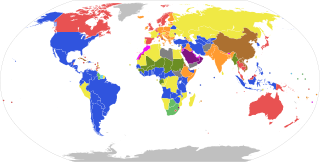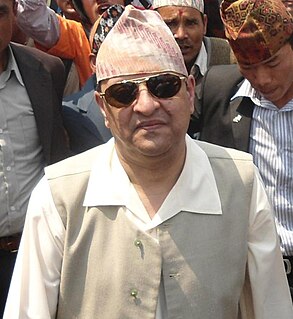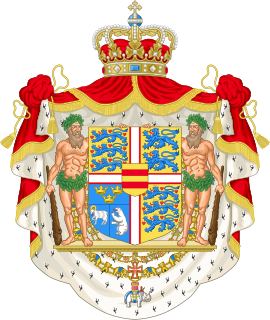
- (1). Crown Prince Paras (born 1971)
- (2). Prince Hridayendra (born 2002)
- (3). Princess Purnika (born 2000)
- (4). Princess Kritika (born 2003)
- (5). Princess Prerana (born 1978)
- (6). Parthav Bahadur Singh (born 2004)
- (1). Crown Prince Paras (born 1971)
End of monarchy
By an overwhelming majority, on Friday, 28 December 2007, the makeshift Nepalese Parliament voted to abolish the monarchy in favor of a republic. The abolition was officially approved on 28 May 2008, by a vote among elected members of the Constituent Assembly. [8] The Rastriya Prajatantra Party Nepal is a party that supports the restoration of the Hindu kingdom in Nepal under the Shah dynasty. [9]
Related Research Articles
A monarch is the head of state in a monarchy. A monarch may exercise the highest authority and power in the state, or others may wield that power on behalf of the monarch. Usually a monarch either personally inherits the lawful right to exercise the state's sovereign rights or is selected by an established process from a family or cohort eligible to provide the nation's monarch. Alternatively, an individual may become monarch by right of conquest, acclamation or a combination of means. A monarch usually reigns for life or until abdication.

A monarchy is a form of government in which a person, the monarch, is head of state for life or until abdication. The political legitimacy and authority of the monarch may vary from purely symbolic, to restricted, to fully autocratic, and can expand across the domains of the executive, legislative and judicial. A monarchy can be a polity through unity, personal union, vassalage or federation, and monarchs can carry various titles such as king, queen, emperor, Raja, khan, caliph, tsar, sultan, or shah.

The politics of Nepal functions within the framework of a parliamentary republic with a multi-party system. Executive power is exercised by the Prime Minister and his/her cabinet, while legislative power is vested in the Parliament.
Primogeniture ( ) is the right, by law or custom, of the firstborn legitimate child to inherit the parent's entire or main estate in preference to shared inheritance among all or some children, any illegitimate child or any collateral relative. In most contexts it means the inheritance of the firstborn son ; it can also mean by the firstborn daughter.
The 1810 Act of Succession is one of four Fundamental Laws of the Realm and thus forms part of the Swedish Constitution. The Act regulates the line of succession to the Swedish Throne and the conditions which eligible members of the Swedish Royal Family must abide by in order to remain in it.

A crown prince is the male heir apparent to the throne in a royal or imperial monarchy. The female form of the title is crown princess, which may refer either to an heir apparent or, especially in earlier times, to the wife of the person styled crown prince.

Gyanendra Bir Bikram Shah Dev reigned as the King of Nepal from 2001 to 2008. As a child, he was briefly king from 1950 to 1951, when his grandfather, Tribhuvan, went into exile in India with the rest of his family. His second reign began after 2001 Nepalese royal massacre. He was deposed by the first session of the Constituent Assembly on 28 May 2008, thereby declaring the nation as the Federal Democratic Republic of Nepal and abolishing the 239 years reign of Shah Dynasty.

The Danish Act of Succession, adopted on 27 March 1953, restricts the throne to those descended from Christian X and his wife, Alexandrine of Mecklenburg-Schwerin, through approved marriages. Succession is by a change in the law in 2009 governed by absolute primogeniture.

Since 1983, the crown of the Netherlands passes according to absolute primogeniture. From 1814 until 1887, a monarch could only be succeeded by their closest female relative if there were no eligible male relatives. Male-preference cognatic primogeniture was adopted in 1887, though abolished when absolute primogeniture was introduced in 1983. Proximity of blood has been taken into consideration since 1922, when the constitution was changed to limit the line of succession to three degrees of kinship from the current monarch. In a situation where the monarch is succeeded by an eligible aunt or uncle, persons previously excluded could be reintroduced into the line of succession.

The Danish royal family is the dynastic family of the monarch. All members of the Danish royal family except Queen Margrethe II hold the title of Prince/Princess of Denmark. Dynastic children of the monarch and of the heir apparent are accorded the style of His/Her Royal Highness, while other members of the dynasty are addressed as His/Her Highness. The Queen is styled Her Majesty.

The Shah dynasty, also known as the Shahs of Gorkha or the Royal House of Gorkha, was the ruling Chaubise Thakuri dynasty from the Indian subcontinent; they claimed Rajput origin from medieval India, and derived from the Gorkha Kingdom from 1559 to 1768 and later the unified Kingdom of Nepal from 1768 to 28 May 2008.

The Kingdom of Romania was a constitutional monarchy in Central-Eastern Europe, ruled by a royal family that was a branch of the Hohenzollern dynasty. The kingdom existed from 1881, when Carol I of Romania was proclaimed king, until 1947, when the last king, Michael I of Romania, abdicated and the Parliament proclaimed Romania a republic. Soon after, upon the establishment of the constitution of 13 April 1948, Romania became a popular republic, a regime that lasted until 1989.

Hridayendra Shah is a member of the Nepalese Royal Family and was the second in line to Nepal's royal throne. The monarchy was officially abolished on 28 May 2008. Until the abolition of the monarchy he was known in Nepal by the title Nava Yuvaraj.
Purnika Rajya Lakshmi Devi Shah of Nepal is the eldest daughter of Paras, former Crown Prince of Nepal and former Crown Princess Himani. She is a granddaughter of former King Gyanendra and Queen Komal
Komal Rajya Lakshmi Devi Shah is the wife of King Gyanendra of Nepal. She was the last Queen consort of Nepal before the Monarchy was abolished on 28 May 2008.

Kritika Rajya Lakshmi Devi of Nepal is the youngest daughter of Crown Prince Paras and Crown Princess Himani. She is a granddaughter of King Gyanendra.
A referendum on changing the Danish Act of Succession, the rules governing the succession to the Danish throne, was held in Denmark, the Faroe Islands, and Greenland on 7 June 2009, simultaneously with the election to the European Parliament, in Denmark proper.

The Monarchy of Denmark, colloquially known as the Danish Monarchy, is a constitutional institution and a historic office of the Kingdom of Denmark. The Kingdom includes Denmark proper, as well as the autonomous countries of the Faroe Islands and Greenland. The Kingdom of Denmark was already consolidated in the 8th century, whose rulers are consistently referred to in Frankish sources as "kings". Under the rule of King Gudfred in 803 the Kingdom may have included all the major provinces of medieval Denmark. The current unified Kingdom of Denmark was founded or re-united by the Viking kings Gorm the Old and Harald Bluetooth in the 10th century. Originally an elective monarchy, it became hereditary only in the 17th century during the reign of Frederick III. A decisive transition to a constitutional monarchy occurred in 1849 with the writing of the first Constitution. The current Royal House is a branch of the princely family of Glücksburg, originally from Schleswig-Holstein in modern-day Germany, the same royal house as the Norwegian and former Greek royal families.

The King of Nepal was Nepal's head of state and monarch from 1768 to 2008. He served as the head of the Nepalese monarchy—Shah Dynasty. The monarchy was abolished on 28 May 2008 by the 1st Constituent Assembly. The subnational monarchies in Mustang, Bajhang, Salyan, and Jajarkot were also abolished in October.
This is a list of the current heads of the former royal houses of countries where a monarchy has either been abolished, suspended or replaced by a new house.
References
- ↑ "The National Online Journal". Nepal Monitor. Retrieved 2015-10-30.
- ↑ "Home". Nepaliaawaz.com. 2011-08-22. Retrieved 2015-10-30.
- ↑ Archived October 14, 2008, at the Wayback Machine
- ↑ "Nepali Times". Nepali Times. Retrieved 2015-10-30.
- ↑ [ dead link ]
- ↑ "Account Suspended". Gorkhapatra.org.np. Retrieved 2015-10-30.[ dead link ]
- ↑ Archived November 7, 2007, at the Wayback Machine
- ↑ "South Asia | Nepal votes to abolish monarchy". BBC News. 2008-05-28. Retrieved 2015-10-30.
- ↑ Nepalnews.com Mercantile Communications Pvt. Ltd [ permanent dead link ]